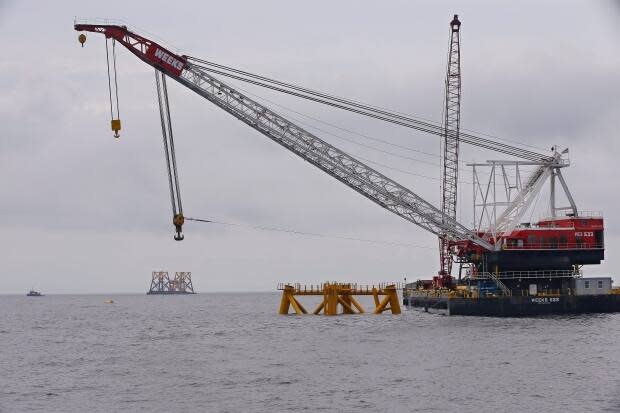Nova Scotia looking for ways to attract offshore wind industry
It may be many years before turbines jut out of the Atlantic Ocean around Nova Scotia to spin wind into energy for the electric grid, but the growth of the offshore wind industry in other parts of the world has sparked the province's interest.
"In Nova Scotia we are blessed with a long coastline. We're blessed with a tremendous wind resource," said Alisdair McLean, executive director of the Offshore Energy Research Association, which is using $50,000 from the provincial government to commission a report on offshore wind potential.
The association wants to find out how Nova Scotia might use government policy to attract the offshore wind industry to build wind farms off the province's coasts, where winds are typically stronger than over land.
"The purpose of our work is to try to understand whether it could be viable in Nova Scotia or not," McLean said in a recent interview.
"Although it is viable in other jurisdictions, clearly, every jurisdiction has its own peculiarities. And so our role here is to evaluate whether or not it could be useful and productive and affordable in Nova Scotia."
Nova Scotia already has hundreds of turbines at dozens of wind farms across the province. They generate about 20 per cent of the electricity on Nova Scotia's grid, and make up the single largest renewable energy source, but they're all onshore.
Offshore wind energy farms were established in parts of Europe in the 1990s and the industry is still growing. The European Union released an offshore renewable energy strategy last fall that includes a goal of increasing offshore wind capacity five-fold by 2030, and five-fold again by 2050.
The offshore wind industry started developing in the U.S. more recently, particularly along the Eastern Seaboard. According to the American Office of Energy Efficiency and Renewable Energy, the country's first offshore wind farm started operating off Rhode Island in 2016.
Targets difficult to meet
All the while, Nova Scotia has renewable energy targets that are proving difficult to meet. In 2020, renewable energy sources made up about 30 per cent of electricity on the grid — 10 per cent shy of what the province had hoped to achieve by last year.
After the already-troubled Muskrat Falls hydroelectric project faced further delays in 2020, Nova Scotia's 40 per cent renewable energy target has been pushed back to 2022.
McLean said "there's no way" any offshore wind projects would develop quickly enough to help achieve that goal, but offshore could fit in with the province's longer-term goals, like reducing greenhouse gas emissions to net-zero by 2050.

Dan Roscoe said he expects to see more onshore wind farms built in Nova Scotia before any offshore development begins.
Roscoe, an engineer and lead of renewable energy at Cape Breton University's Verschuren Centre for Sustainability in Energy and the Environment, said jurisdictions where offshore wind has taken off typically have space constraints on land, which is not currently a problem in Nova Scotia.
"I think what it comes down to is what are we going to use that offshore wind energy for? And how can we get it to a spot where it's going to be cost-competitive?" Roscoe said.
According to Nova Scotia Power's latest resource plan, released last fall, the cost of generating offshore wind in Nova Scotia in 2021 would be about double the cost of onshore wind — $113 per megawatt hour versus $56 per megawatt hour.
The utility has forecast the cost of generating energy from both sources will drop, and the gap between them will tighten. By 2045, NSP's plan predicts onshore wind will cost $44 per megawatt hour and offshore will cost $59 per megawatt hour.
Roscoe said wind energy costs are coming down in part because of the economies of scale. Wind turbines are getting bigger, with some recent offshore projects boasting capacities as high as one gigawatt — "which would be more than half the demand and roughly half of the needs of Nova Scotia, all in one project."
In order to make projects of that size viable in Nova Scotia, Roscoe said some of the power generated would likely have to be sold for export.
Researchers pinpoint best locations for wind energy
Two researchers at Dalhousie University's Renewable Energy Storage Lab just published some findings that they think might help with the cost of wind energy.
Mechanical engineering professor Lukas Swan and research engineer Nathaniel Pearre mapped out the best places around the Maritime provinces for wind farms, with an eye to mitigating one of the resource's major drawbacks: variability.
Because wind speed and strength are constantly changing, the amount of energy generated through wind turbines is also constantly changing.

At peak, there can be congestion on the grid. At base, wind power needs to be backed up by other energy sources.
Swan and Pearre's mapping study shows potential wind farm locations around the Maritimes that could naturally balance what's already on the grid.
"To put it into a bullet point … if you build out more resources towards the periphery of the area, the better," Pearre said in an interview.
In Nova Scotia, the offshore area around Sable Island scored well, according to the researchers, as did parts of the Bay of Fundy, on the New Brunswick side. Onshore, they found potential in parts of Cape Breton and northwestern New Brunswick.
Swan said he thinks offshore wind's potential deserves more exploration in Nova Scotia, but he isn't counting on the industry exploding any time soon.
"Everything is harder than it looks and probably takes a little bit longer than you'd think."
MORE TOP STORIES

